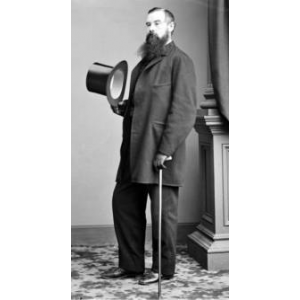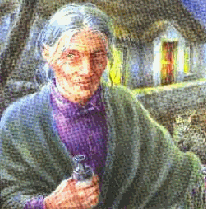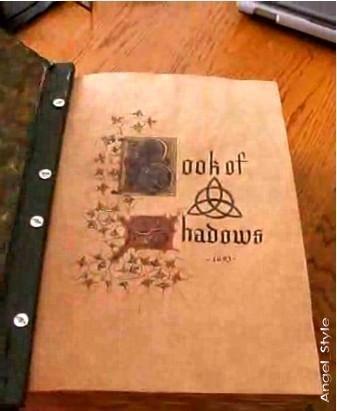 In 1856 Leland married and became deeply devoted to his wife of 46 years ‘Eliza Bella “Isabel” Fisher’. While acting as an editor for Graham's Magazine, he published the first of his German-English poems “Hans Breitmann's Party” (1857). These he wrote in a mixture of German and broken English, imitating the dialect and humour of the Philadelphia Germans (also called Pennsylvania Dutch). Collectively they were first published in the 1860’s and 1870’s and so popularized Leland that he soon became a sought-after and prosperous writer. The poems were later collected in “The Breitmann Ballads” (newly edited in 1895).
In 1856 Leland married and became deeply devoted to his wife of 46 years ‘Eliza Bella “Isabel” Fisher’. While acting as an editor for Graham's Magazine, he published the first of his German-English poems “Hans Breitmann's Party” (1857). These he wrote in a mixture of German and broken English, imitating the dialect and humour of the Philadelphia Germans (also called Pennsylvania Dutch). Collectively they were first published in the 1860’s and 1870’s and so popularized Leland that he soon became a sought-after and prosperous writer. The poems were later collected in “The Breitmann Ballads” (newly edited in 1895).
It was about this time in the late 1850’s and during the build up to the American Civil War of 1861-65, that Leland developed strong pro-Union sentiments, and founded the Continental Monthly, a pro-Union Army publication to support their views. He coined the term “emancipation” as an alternative to “abolition” in referance to the Union’s anti-slavery position. After the war broke out on the 12th April 1861, Leland enlisted in 1863 and joined an emergency regiment at the Battle of Gettysburg. After the war ended Leland traveled extensively throughout America developing his knowledge of folklore and the occult. On one occasion he tried his hand at prospecting for oil and on another while traveling through the old Wild West, he stayed for a short visit with General Custer at Fort Harker.
During his travels he lived and studied with the Algonquin Indians for months at a time recording their stories, myths and legends. He also studied the myths and legends of the Eskimos, the Finno-Ugric languages of the Finns and Lapps, and delved into the anthropology of a number of Mongoloid peoples. He found parallels in various Norse and North American Indian myths in as much as the Algonquin Indian stories could be related to Norse legends, he then developed a theory on their themes. He postulated that certain myths had spread from Greenland down to Canada and into Northeastern America. Leland’s studies led him to the conviction that the US did not have a meaningful legitimate folk ethos, and maintained that the American Indians understood nature and spirituality better than even Ralph Waldo Emerson or Walt Whitman.
In 1869 Leland’s father died, and with the inheritance from his estate together with the income he was generating from sales of his “Breitmann” poems, Leland abandoned journalism, being able finically to pursue his interest in folklore, mysticism and the occult. In 1870 he moved to England and began his study of the English Gypsies. Over the course of time he won the confidence of the then “King of the Gypsies” in England, Matty Cooper. From Cooper, Leland learned to speak Romany the language of the Gypsies, but it took many years before the Gypsy people accepted him as one of their own. They called him Romany Rye, meaning a non-Gypsy who associates with Gypsies.
Surviving the death of his beloved wife Isabel on the 09th July 1902, Leland himself died on the 20th of March 1903 in Florence. He had suffered with in ill health for the pervious seven years, and toward the end a bout of pneumonia and resulting heart problems caused his death. Leland was cremated in Florence and his ashes returned to America, where they were buried at Laurel Hill Cemetery, Philadelphia, PA.
Elizabeth Robins Pennell, Leland’s niece who inherited much of his notes, letters and unpublished materials, wrote a two-volume biography on him: Charles Godfrey Leland: a Biography (published in Boston by Houghton, Mifflin and Co in 1906). Her biography is filled with comments on his early passionate interests in witchcraft, magic and the occult, of his passion she writes:
“As might be expected of the man who was called “Master” by the Witches and Gypsies, and whose pockets were always full of charms and amulets, who owned the Black Stone of the Voodoo’s, who could not see a bit of red string at his feet and not pick it up, or find a pebble with an hole in it and not add it to his store – who in a word, not only studied Witchcraft With the impersonal curiosity of the scholar, but practiced with the zest of the initiated”.
Sadly Leland departed without completing his work on Italian Witchcraft, however his legacy lives on through his books. Until his time, no other books existed claiming to contain material obtained directly from a practicing witch. His book Aradia: Gospel of the Witches became one of the most influential works to affect and influence Modern Witchcraft and Wicca. It is also one of the few books on witchcraft to remain in print for over one hundred years.
A select bibliography:
1855: Meister Karl's Sketch-book
1855: Mystery of Dreams
1856: Piaui es of Travel
1862: Sunshine in Thought
1862: Heine's Book of Songs
1864: Legends of Birds
1870: Music Lesson of Confucius
1871: Hans Breitmann Ballads
1872: Pidgin-English Sing-Song
1873: The English Gipsies
1873: Egyptian Sketch Book
1879: Johnnykin and the Goblins
1879: Life of Abraham Lincoln
1880: The Minor Arts
1882: The Gypsies
1883: Industrial Education
1884: Algonquin Legends of New England
1889: A Dictionary of Slang (with Albert Barrerre)
1891: Gyspsy Sorcery and Fortune Telling
1892: The Hundred Riddles of the Fairy Bellaria
1892: Etruscan Roman Remains in Popular Tradition
1893: Memoirs
1895: The Breitmann Ballads (newly edited)
1895: Songs of the Sea and Lays of the Land
1896: Legends of Florence Collected from the People (2 vols.)
1897: Hundred Profitable Acts
1899: Unpublished Legends of Virgil
1899: Aradia, or the Gospel of the Witches
1899: Have You a Strong Will?
1901: Legends of Virgil
1902: Flaxius, or Leaves from the Life of an Immortal
1903: Kuloskap the Master, and other Algonquin Poems (with J. Dyneley Prince)
Free e-books (can be downloaded):
Tuesday Lobsang Rampa - Chapters Of LifeMarty Dodge - Reviews Of Leo Ruckbie Work
Aleister Crowley - The Confessions Of Aleister Crowley An Autohagiography














